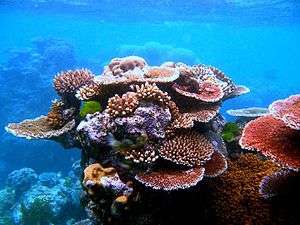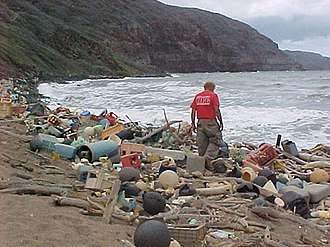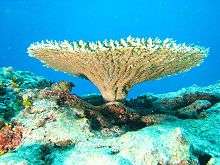Coral reef protection
Coral reef protection is the process of modifying human activities to avoid damage to healthy coral reefs and to help damaged reefs recover. The key strategies used in reef protection include defining measurable goals and introducing active management and community involvement to reduce stressors that damage reef health. One management technique is to create Marine Protected Areas (MPAs) that directly limit human activities such as fishing.[1]

Recreational scuba diving can have a measurable adverse impact on tropical coral reefs, mostly due to contact damage of brittle and fragile branched stony corals. This can be reduced by improving diver buoyancy and trim skills, and by educating divers on the consequences of clumsy behaviour on the reef ecosystem.[2][3]
It takes approximately 10 thousand years for coral polyps to form a reef, and between 100,000 and 30 million years for a fully mature reef to form.[4]
Coral reefs
Coral reefs are among the most productive and biologically diverse ecosystems on Earth.[5] Differences in exposure to wave patterns create a variety of habitat types.[6] The coral need a mutualistic symbiotic relationship with zooxanthellae algae in order to build a reef. The single celled algae derive their nutrients by using photosynthesis, and the coral provide shelter to the algae in return for some of the nutrients.[4] Zooxanthellae populations can die with changing environmental conditions, causing the coral to lose color, known as coral bleaching.[7] Coral receive their vibrant colors from the different species of zooxanthellae that inhabit them.
Ecosystem services
Corals provide millions of people with ecosystem services such as fisheries, medicine, tourism and recreation, coastal protection as well as aesthetic and cultural benefits,[5] yet they constitute a mere 0.2% of the world's marine ecosystems.[8]
Biodiversity
Also known as the "rainforests of the sea," coral reefs cover 1% of the ocean yet provide a habitat to over 9 million species, approximately one fourth of all marine life, for food, shelter, and even hunting grounds for predators.[9][10] Species found on coral reefs include fish, invertebrates, birds, and megafauna such as sharks, sea turtles, and marine mammals.[9] Finally, they serve as essential spawning, nursing, and breeding grounds for numerous organisms.[11]
Coastal Protection
Coral reefs provide complex structures that buffer the ocean's waves, protecting coastlines from strong currents and nasty storms. Approximately 500 million people live within 100 km of coral reefs and rely on them for this protection. Not only are they critical in preventing the loss of lives, property damage, and erosion, but they also serve as a barrier for harbors and ports that depend on them economically.[9]
Fisheries
Over a billion people globally depend on the fish that live among coral reefs as a major food source.[12] It is estimated that half of all US commercial and recreational fisheries depend on coral reefs to provide them over $100 million annually.[9] Globally, fisheries account for $5.7 billion of the net income provided by coral reefs.[12]
Medicine
Species found in coral ecosystems produce chemical compounds that are used to develop new medicines to treat cancer, arthritis, asthma, heart disease, ulcers, bacterial infections, and viruses.[13] As early as the 14th century, the medicinal properties of coral reef dwelling species were utilized. Antiviral extracts and tonics continue to be studied and toxic compounds such as neurotoxins discovered in coral reefs have proven beneficial as painkillers. The limestone skeleton of coral has been tested and used for human bone grafts, due to its porous nature and has a lower rate of rejection than artificial bone graft materials.[14]
Tourism & Recreation
Millions of scuba divers and snorkelers visit coral reefs every year to observe their incredible beauty, as well as beachgoers who are protected by the reefs. Local economies rely heavily on coral reefs, receiving about $9.6 billion through diving tours, recreational fishing trips, hotels, and restaurants.[12]
General interests
There are four main categories of interest the public should have for the preservation of coral reefs: the preservation of natural beauty and value, the promotion of the local economy, potential source of new biological products, and preservation of the world ecosystems of which they are a part.
Over one-third of marine species live in coral reef ecosystems. These provide a beautiful underwater experience for snorkelers and divers with a significant tourism value.[15][3] This great genetic biodiversity has a lot of potential for industries like pharmaceutics, biochemistry, and cosmetics. This biodiversity also boosts the economy through an increase in marine tourism and commercial fisheries. Long-term, coral reefs have been recognized as large contributors to the absorption of carbon dioxide emissions which has been an important part of the mitigation of climate change.[16]
Stressors
Two types of stressors are associated with reef systems: natural and human-induced. The effects of these stressors can range from negligible to catastrophic.

The warming waters, ocean pH changes and sea level rise associated with climate change operate on a global basis.[17][18]
Localized examples include residential, developmental, agricultural and industrial runoff, sedimentation from land clearing, human sewage and toxic discharges.[19]
Acute stressors can inflict other damage, via unsustainable fishing practices, boat anchors or accidental groundings. Some fishing practices are destructive to reef habitats, such as bottom trawling, dynamite fishing and cyanide fishing. Ghost fishing (unintended damage from abandoned fishing equipment) harms many coral reefs. Even small-scale fishing can damage reefs if herbivores are removed and thereby not allowed to protect reefs from encroachment by algae.[20] Boaters can damage coral by dropping their anchors on reefs instead of sand.[21] Accidental boat groundings can obliterate areas of coral reef. Lettuce corals and branching corals such as elkhorn and finger coral are fragile, but even massive boulder corals can be crushed or broken and turned upside down to die by a sailboat keel. Groundings in sand, or even the churning action of propellers, can cause major localized siltation, indirectly killing adjacent corals.[22]
During the 20th century recreational scuba diving was considered to have generally low environmental impact, and was consequently one of the activities permitted in most marine protected areas. Basic diver training has concentrated on an acceptable risk to the diver, and paid less attention to the environment. The increase in the popularity of diving and in tourist access to sensitive ecological systems has led to the recognition that the activity can have significant environmental consequences.[2]
Scuba diving has grown in popularity during the 21st century, as is shown by the number of certifications issued worldwide.[23] Scuba diving tourism is a growth industry, and it is necessary to consider environmental sustainability, as the expanding impact of divers can adversely affect the marine environment in several ways, and the impact also depends on the specific environment. Tropical coral reefs are more easily damaged by poor diving skills than reefs where the environment is more robust. The same pleasant sea conditions that allow development of relatively delicate and highly diverse ecologies also attract the greatest number of tourists, including divers who dive infrequently, exclusively on vacation and never fully develop the skills to dive in an environmentally friendly way.[24]
Sediment
Sediment pollution from land has severe consequences for coral reef ecosystems. However, even along one coastline, separate reefs can experience different water flow conditions that affect sediment distribution. A 2015 study assessed sediment from two streambeds less than a mile apart on the island of Lānaʻi, Hawaii. One site experienced quick-moving currents that efficiently flushed away sediment, protecting the reef, while the other was subjected to currents and wave conditions that allowed sediment to be continuously re-suspended in the water, starving the reef of light.[25]
Overfishing
The vast biodiversity of coral reefs consequently create an abundant fishing area for locals. This leads to overfishing of reef herbivore organisms which makes the coral reefs more vulnerable and unable to recover from large environmental disturbances.[26] Unfortunately, most marine ecologists expect future oceans to be more overfished than now.[27]
Restoration

It is difficult to create a substantial plan for the protection of coral reefs due to their location out in open water; there is no distinct ownership over certain parts of the ocean, which creates difficulty in delegating responsibility.[27] But private and government groups whose purpose is to help the environment have made steps towards the restoration of coral reefs.
The aim of coral restoration is to help coral adapt to stressors and changing environments. NOAA's Coral Reef Conservation Program and Damage Assessment, Remediation and Restoration Program approaches restoration by responding to and restoring physically damaged reefs, preventing the loss of habitat, implementing coral conservation projects, focusing on restoring endangered coral species and controlling invasive species.[28] The Coral Restoration Foundation has restored over 100 genotypes of staghorn corals (Acropora cervicornis) using coral nurseries, and also has research goals of determining ecological success, ideal restoration locations and how surrounding organisms affect restoration.[29] Laboratories located near reefs, such as Elizabeth Moore International Center for Coral Reef Research & Restoration — which has planted more than 43,000 corals in the Florida Keys — play a crucial role in maintaining these nurseries.[30]
Managing stream flow
Sediment flux can be reduced in steep watersheds on montane tropical islands in the Hawaiian archipelago by restoring vegetation and controlling invasive species. Gabions — check dams — created by planting normally invasive kiawe trees by a local community group, stopped 77 tons of sediment from flowing into the ocean that would have needed about five weeks of natural water flow to flush from the reef.[25]
Coral nurseries
Coral aquaculture, the process of using coral nurseries to restore the world's reefs is a project that is capable of improving biodiversity, structural integrity and coral cover.[31] Coral nurseries can provide young corals for transplantation to rehabilitate areas of reef decline or physical damaged. In this process, coral gametes are harvested from spawning grounds and grown in a laboratory environment, then replanted when they grow larger. This allows the coral to grow safely in controlled amounts under lab conditions.[32] Nurseries can begin as small patches of rescued coral colonies, and may be salvaged and restored before transplantation.[33] In 2009, The Nature Conservancy began to grow over 30,000 young coral in underwater nurseries in Florida and the Caribbean for transplantation.[34]
Marine protected areas

Marine protected areas (MPAs) have become an increasingly prominent tool for reef management. MPAs promote responsible fishery management and habitat protection. Much like national parks and wildlife refuges, and to varying degrees, MPAs restrict potentially damaging activities. MPAs encompass both social and biological objectives, including reef restoration, aesthetics, biodiversity and economic activity. MPAs have not been universally accepted. Conflicts relate to lack of participation, clashing views, effectiveness and funding. Many MPAs offer inadequate protection for coral reefs. Only 27% of coral reefs are in MPAs globally. Only 15% of MPA sites were considered effective, with 38% partially effective and 47% ineffective. This leaves only 6% of coral reefs in effectively managed MPAs.[35] In some situations, as in Kiribati's Phoenix Islands Protected Area, MPAs provide revenue that is potentially equal to the income they would have generated without controls.[36]
Biosphere reserve, marine park, national monument and world heritage status can protect reefs. For example, Belize's Barrier reef, Chagos archipelago, Sian Ka'an, the Galapagos islands, Great Barrier Reef, Henderson Island, Palau and Papahānaumokuākea Marine National Monument are world heritage sites. The Parcel de Manuel Luís Marine State Park protects the largest coral reef in the South Atlantic.[37] This became a Ramsar Site in February 2000.[38]
In Australia, the Great Barrier Reef is protected by the Great Barrier Reef Marine Park, and is the subject of much legislation, including a biodiversity action plan.
Inhabitants of Ahus Island, Manus Province, Papua New Guinea, have followed a generations-old practice of restricting fishing in six areas of their reef lagoon. Their cultural traditions allow line fishing, but not net or spear fishing. The result is both the biomass and individual fish sizes are significantly larger than in places where fishing is unrestricted.[39][40]
See also
References
- "Coral Reefs". National Fish and Wildlife Foundation.
- Hammerton, Zan (2014). SCUBA-diver impacts and management strategies for subtropical marine protected areas (Thesis). Southern Cross University.
- Johansen, Kelsey (2013). "Education and training". In Musa, Ghazali; Dimmock, Kay (eds.). Scuba Diving Tourism: Contemporary Geographies of Leisure, Tourism and Mobility. Routledge. ISBN 9781136324949.
- "Stanford : Types of Reefs". web.stanford.edu. Retrieved 3 September 2019.
- Moberg, Fredrik; Folke, Carl (1999). "Ecological goods and services of coral reef ecosystems". Ecological Economics. 29 (2): 215–233. doi:10.1016/s0921-8009(99)00009-9.
- "Stanford : Reef Structure".
- "Stanford : Reef Structure".
- Souter, David W; Lindén, Olof (January 2000). "The health and future of coral reef systems". Ocean & Coastal Management. 43 (8–9): 657–688. doi:10.1016/S0964-5691(00)00053-3.
- "Coral reef ecosystems | National Oceanic and Atmospheric Administration". www.noaa.gov. Retrieved 2019-12-02.
- "Coral Reef Alliance".
- "Value of Corals | Coral Reef Systems". Retrieved 2019-12-02.
- "Value of Corals | Coral Reef Systems". Retrieved 2019-12-03.
- "NOAA National Ocean Service Education: Corals". oceanservice.noaa.gov. Retrieved 2019-12-03.
- "NOAA".
- Done, Terry (2004). "Coral Reef Protection". Issues in Science & Technology. 20 (3): 14–16 – via Academic Search Complete.
- Caillaud, Anne (2012). "Preventing Coral Grief: A Comparison Of Australian And French Coral Reef Protection Strategies In A Changing Climate". Sustainable Development Law & Policy. 12 (2): 26–64 – via Academic Search Complete.
- "Water Resources". 2016-11-08.
- Wagner, D. E.; Kramer, P.; Van Woesik, R. (2010). "Species composition, habitat, and water quality influence coral bleaching in southern Florida". Marine Ecology Progress Series. 408: 65–78. Bibcode:2010MEPS..408...65W. doi:10.3354/meps08584.
- "How Sunscreen May Be Destroying Coral Reefs".
- "WWF - Fishing problems: Destructive fishing practices". WWF Global. Retrieved 23 April 2015.
- Bartels, Paul. "Fragile reefs: handle with care." Cruising World 22.n1 (Jan 1996). 15 Oct. 2009 .
- "Gale - Enter Product Login".
- Lucrezi, Serena (18 January 2016). "How scuba diving is warding off threats to its future". The Conversation. Retrieved 5 September 2019.
- Dimmock, Kay; Cummins, Terry; Musa, Ghazali (2013). "Chapter 10: The business of Scuba diving". In Musa, Ghazali; Dimmock, Kay (eds.). Scuba Diving Tourism. Routledge. pp. 161–173.
- "Study clears the waters on a dirty threat to Hawai'i's reefs –..." Human Nature – Conservation International Blog. 2016-01-20. Retrieved 2016-02-21.
- Rasher, Douglas (2012). "Effects of Herbivory, Nutrients, And Reef Protection On Algal Proliferation And Coral Growth On A Tropical Reef". Oecologia. 169 (1): 187–198. Bibcode:2012Oecol.169..187R. doi:10.1007/s00442-011-2174-y. PMC 3377479. PMID 22038059 – via Academic Search Complete.
- Lowe, Phillip (2011). "Empirical Models Of Transitions Between Coral Reef States: Effects of Region, Protection, and Environmental Change". PLOS One. 6 (11): 1–15. Bibcode:2011PLoSO...626339L. doi:10.1371/journal.pone.0026339. PMC 3206808. PMID 22073157.
- "NOAA Habitat Conservation". Archived from the original on 2015-04-23. Retrieved 2015-05-07.
- "Coral Restoration Foundation". Archived from the original on 2015-05-18.
- "Coral Reef Restoration | Mote Field Stations". mote.org. Retrieved 2019-10-24.
- Gateño, D. (1998). "Aquarium Maintenance of Reef Octocorals Raised from Field Collected Larvae". Aquarium Sciences and Conservation. 2 (4): 227–236. doi:10.1023/A:1009627313037.
- "BBC News". 2013-08-21.
- "Florida Keys NOAA".
- "The Nature Conservancy". Archived from the original on 2015-05-18. Retrieved 2015-05-09.
- "Reefs at Risk Revisited" (PDF). World Resources Institute. February 2011. Retrieved March 16, 2012.
- "Phoenix Rising". National Geographic Magazine. January 2011. Retrieved April 30, 2011.
- Edison Lobão; Fernando César de Moreira Mesquita (11 June 1991), Decreto nº 11.902 de 11 de Junho de 1991 (PDF) (in Portuguese), State of Maranhão, retrieved 2016-08-03
- Marcelo Carota (23 January 2015), Parcel de Manuel Luís, sítio Ramsar e parque marinho (in Portuguese), MMA: Ministério do Meio Ambiente, archived from the original on 23 May 2015, retrieved 2016-08-03
- Cinner, Joshua E.; MARNANE, Michael J.; McClanahan, Tim R. (2005). "Conservation and community benefits from traditional coral reef management at Ahus Island, Papua New Guinea". Conservation Biology. 19 (6): 1714–1723. doi:10.1111/j.1523-1739.2005.00209.x-i1.CS1 maint: ref=harv (link)
- "Coral Reef Management, Papua New Guinea". Nasa's Earth Observatory. Retrieved 2 November 2006.
Further reading
- National Academies of Sciences, Engineering, and Medicine (2019). A Research Review of Interventions to Increase the Persistence and Resilience of Coral Reefs. Washington, DC: The National Academies Press. doi:10.17226/25279. ISBN 978-0-309-48535-7.CS1 maint: multiple names: authors list (link)

External links
- Maui Coral Reef Recovery Team (2012). "Maui Coral Reef Recovery Plan" (PDF). mnmrc.org. Maui Nui Marine Resource Council. Retrieved 2016-02-21.
